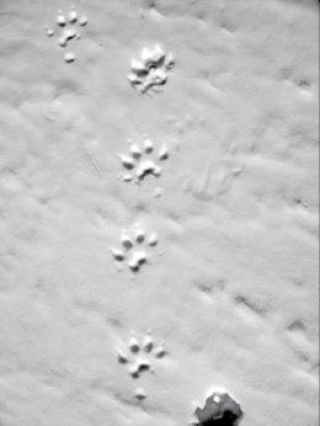Lynx, cougars, grizzlies, black bears, wolverines, marten, weasels, moose, deer, and more live in the woods near our town, and now the Friends of the Rossland Range (FORR) are asking for everybody’s help to track them.
Jenny Coleshill, the ecologist who is heading up the project she calls “Trax FoRR Tracks,” wants people to keep an eye out for wildlife tracks when they’re outside in the snow, and then send her an e-mail with pictures and the map co-ordinates.
“What better field crew to have take data other than the skiers of Rossland who I know care about this stuff,” she said. “And the best time of the year to know where animals are is wintertime because they leave their tracks.”
Coleshill tells us the system is all set up, but how does it work?
If you see a track, try to identify it. Put something next to one of the prints for scale — like a pen or a lens cap — and snap both a close-up of the print and one to show the gait of the animal over several prints.
“If you have a GPS, you could mark the location, or you could pull it off a map,” she said. “Then send it to the email address: trax4tracks@rosslandrange.org.”
Is she interested in all the tracks, even rabbits, squirrels, and voles?
“I think people should learn what all the tracks are, because it’s just cool to know and a good thing for kids to learn, a good family thing to do,” Coleshill said. “But really, I don’t want to get a hundred emails with squirrel tracks.”
“The big one,” she added, “someone’s going to get a prize if they get a wolverine track.”
Wolverines need a really wide area to roam, Coleshill explained, and lynx as well.
Wolverines are large weasels with prints like a small bear’s foreprint, but cats are easy to identify: Felines’ nails retract and don’t show in the print, but canines have claws in their prints.
“We’re trying to get recreational tenure over the Rossland Range area and part of that is becoming stewards of the area, including wildlife values,” she said.
Different land use practices apply to an area depending on the abundance and distribution of the local wildlife, for example if there’s a wolverine known in the area, or a well-used corridor that could be protected.
“The government isn’t really providing much in terms of stewardship for wildlife,” she explained. “[The Ministry of Environment] do some good things, but they just don’t have the resources.”
“They really do rely on people on the ground doing this kind of stuff. They use that data and it’s a good way to monitor the wildlife out here.”
With Trax FORR Tracks, Coleshill hopes to build an inventory of locations for each species, and to this end has distributed a pamphlet of instructions to several cabins and local stores.
She got the idea for the project at a conference in Seattle. “The Washington Wildlife Habitat Connectivity Working Group did a lot of ecological modeling about corridors and climate change, and they modeled individual species and where they would travel,” she said.
She explained that the model is a mapping tool to analyze animals’ habitat preferences. “Usually that means close to water sources. If it’s caribou, for example, they need lichen to survive. If it’s wolverines or grizzly bears, they’re really human sensitive, so they don’t like human activity,” she said.
After the model’s all set up, they punch in the variables about distance to roads, creeks, food, and so forth to come up with a map.
The Washington group identified four vital corridors - the Kettle River, the P’en d’Oreille River, and in between that whole area. “It’s super important for multiple species that they identified,” she said.
“I thought, that’s super cool, it’s got to happen here in Rossland.”
This isn’t Coleshill’s full time work, however, she hopes she’ll get funding this summer to monitor grizzlies in the area, using a hair-snag approach to get data on their DNA.
“The seven summits trail is awesome, it’s an amazing trail, it’s world renowned,” she said, “but it cuts through some really important grizzly bear habitat and displaced them quite a bit. We don’t even know what the effect of that is because nobody’s been monitoring them.”
For more information on Trax FORR Tracks, contact Coleshill at trax4tracks@rosslandrange.org, or call 362-7474.
